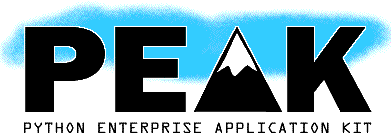

| FrontPage |
UserPreferences |
| The PEAK Developers' Center | FrontPage | RecentChanges | TitleIndex | WordIndex | SiteNavigation | HelpContents |
NOTE: Due to rampant spammer edits, this wiki is no longer open to public editing. Email me your user name and login ID if you want to get access. (If your name isn't shown in the upper right corner of this page, you can click on "UserPreferences" to sign up (with a valid e-mail address) and log in. However, to actually edit anything, I'll need to grant permission to your login first.)

When beginning to learn PEAK, the best order in which to explore the modules is: binding, config, and naming. These core modules provide the component-oriented framework upon which most other PEAK modules are built, and they will be used extensively within any application built with PEAK.
The next layer to explore should probably be the runtime modules: ?running, commands, and logs. Combined with the previous core modules, the runtime modules provide most of the machinery needed for building PEAK applications.
The storage module provides numerous storage management features, including high level relational database connectivity, a general transaction framework with ACID assurance and two-phase commit, and a ?DataManager framework for high level object persistence to multiple storage media.
The model module provides a framework for implementing the ?DomainModel pattern, which is based on high level "business objects" isolated from storage concerns.
The events module provides an "event-driven" programming framework that supports ultralight "microthreads" implemented via generators. It can stand alone or can be used atop Twisted for a more intuitive approach to asynchronous programming.
Further modules to explore include the ?util, ?metamodels, and ?security modules. The ?web, ?net, and ?query modules are under development.
Additional notes in GettingStartedWithPeak.
The IntroToPeak tutorial is currently the best way to get started with PEAK. It demonstrates the use of many of PEAK's features by building a small application step-by-step.
Other tutorials include:
(To be categorized: AddingPsycopgSupport, DistributePeakApplications, MiscNotes, Glossary, CookBook, MailingListHighlights, IrcHighlights)
You can edit any page by pressing the link at the bottom of the page. Capitalized words joined together form a WikiName, which hyperlinks to another page. The highlighted title searches for all pages that link to the current page. Pages which do not yet exist are linked with a question mark: just follow the link and you can add a definition.
To learn more about what a WikiWikiWeb is, read about ![]() WhyWikiWorks and the
WhyWikiWorks and the ![]() WikiNature. Also, consult the
WikiNature. Also, consult the ![]() WikiWikiWebFaq.
WikiWikiWebFaq.
Interesting starting points: